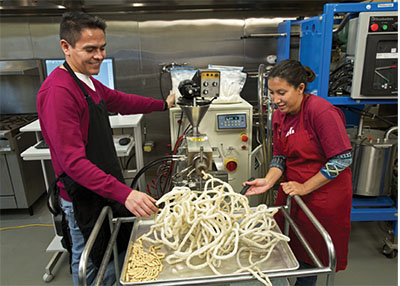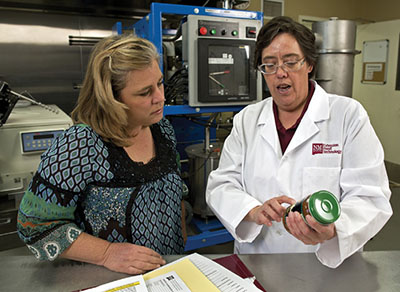Guide E-510B
Revised by Nancy Flores and Jay Lillywhite
College of Agricultural, Consumer and Environmental Sciences, New Mexico State University
Authors: Respectively, Associate Professor/Extension Food Technology Specialist, Department of Extension Family and Consumer Sciences; and Professor/Department Head, Department of Agricultural Economics and Agricultural Business, New Mexico State University. (Print Friendly PDF)
Introduction
This document is the second in a series on starting a food business in New Mexico. Many people dream of owning their own food business and turning a family recipe into a commercial product. Taking a recipe made in a home kitchen into a commercial food processing facility may require some specialized equipment and changes to the formulation. There are also many regulations for food processing in a commercial kitchen. This publication outlines what is involved to make a commercial food product in New Mexico. For more information on starting a food business in New Mexico, visit these resources:
- Guide E-510A: Starting a Food Business in New Mexico: Food Business Management: https://pubs.nmsu.edu/_e/E510A/index
- Guide E-510C: Starting a Food Business in New Mexico: Food Safety: https://pubs.nmsu.edu/_e/E510C/index
Who Are Food Business Entrepreneurs?
Many food-processing businesses start as a family business that is vertically integrated from the family farm, or as an expansion of a restaurant. Most food business entrepreneurs are creative types—food artists who enjoy creating new foods and flavors. A food business adds to the family income and can be anything from a hobby to a major enterprise employing hundreds of people.
What Types Of Food Products Are Made?
New Mexico is known for red and green chile peppers, and the state has spawned many fresh and canned salsa and chile products. There are many other products, such as barbecue sauces, pasta sauces, and salad dressings, that incorporate New Mexico’s chile. Breads, cookies, and tortillas are mostly sold in local markets, including farmers’ markets. Several types of cheese, including flavored goat cheese, are also produced in New Mexico. Most New Mexico meat products are custom orders; however, the state has a thriving beef jerky industry. With a good supply of local pecans, pistachios, and peanuts, chocolate confections and other candy are well known outside of the state. Natural and organic teas and herbs are widely available throughout the state. Because of the success of current New Mexico food products, there are many more opportunities for new innovations.
How Can A Home Recipe Be Commercialized?
So how do you turn grandma’s recipe into a commercial success? Success of a food business is gained by hard work, good business management, imagination, and faith in your product.
The first step is to consider how the product might compete in the market. What does your product offer to the consumer compared to other products already on the market? Simply being a mom-and-pop company is not enough of a hook to engage a consumer to purchase a product, especially on a repeat basis. A food product must be wholesome and somewhat nutritious and offer consumers an experience that will provide comfort or a change of pace—something exciting. Repeat purchases and proper product placement on grocery shelves become critical to grow the business. Faulty food business management, including miscalculated marketing schemes and poor distribution, is more often the demise of a food company than the merits of the food product.
Where Are Food Products Made?
To operate a food-processing business in New Mexico, you must have a permit, and the product must be produced in a regulated food-processing facility as per New Mexico Environment Department (NMED) food service and food processing regulations (NMAC § 7.6.2).
Many food businesses start out in rented space during a restaurant’s off-hours or in a small commercial facility on their residential property. Others may use an incubator kitchen that provides the needed equipment and can be rented by the hour.
As a company grows and the actual production of the product becomes very time-consuming, the business owner may want or need to focus on marketing, promotion, or distribution of the product. A co-packer or contract processor that has a permitted commercial facility that can make large quantities of product is attractive to a smaller firm because it handles larger volumes of product and may reduce production costs compared to smaller batches.
Another option is “toll manufacturing.” Under this arrangement, the food business provides large volumes of raw materials or semi-finished product to the toll manufacturer for further processing (Goldner et al., 2013). Examples of tolling services are freeze drying, extrusion (Figure 1), dehydration, pulverization, or even high-pressure processing. High-pressure processing for products such as avocado, deli meats, smoothies, baby foods, and dairy products is common. High-pressure processing is limited by products containing air and low moisture (S. Martinez-Monteagudo, personal communication, 2021).
Figure 1. NMSU students using an extruder to make a puffed snack in the Extension Food Technology Laboratory.
Commercializing A Product
Initial product development will consider how the product will be sold—fresh, frozen, or canned; at a farmers’ market or grocery store; direct sales; or through food service. There are many steps to follow to commercialize a food product: business structure and product liability, which are discussed in Guide E-510A (https://pubs.nmsu.edu/_e/E510A/index); safe process evaluation, packaging, and labeling, which are discussed in this guide; and facilities, equipment, permits, and regulations, which are discussed in Guide E-510C (https://pubs.nmsu.edu/_e/E510C/index). Each of these topics must be diligently reviewed to have a successful food business.
Safe Process Evaluation
Once the concept of the food product has been developed, the recipe must be evaluated to ensure that a safe process is followed. The product may be tested for pH, water activity, and microbial stability, especially in the case of acidified and canned foods, which are considered “ready-to-eat.” Breads and tortilla products must have a water activity below 0.95 to be unrefrigerated.
A Process Authority must be used to review the formulation and processing steps of an acidified or low-acid canned product. As defined in the Code of Federal Regulations:
“Scheduled processes for low-acid foods shall be established by qualified persons having expert knowledge of thermal processing requirements for low-acid foods in hermetically sealed containers and having adequate facilities for making such determinations. The type, range, and combination of variations encountered in commercial production shall be adequately provided for in establishing the scheduled process.” (21 C.F.R. § 113.83)
“Whenever any process is less than the scheduled process or when critical factors are out of control for any low-acid food or container system as disclosed from records by processor check or otherwise, the commercial processor of that low-acid food shall either fully reprocess that portion of the production involved, keeping full records of the reprocessing conditions or, alternatively, must set aside that portion of the product involved for further evaluation as to any potential public health significance. Such evaluation shall be made by a competent processing authority and shall be in accordance with procedures recognized by competent processing authorities as being adequate to detect any potential hazard to public health.” (21 C.F.R. § 113.89)
Packaging And Labeling
Packaging and labeling issues should be thought out early in product development (Figure 2) because how the product will be sold—refrigerated or shelf-stable—affects the type of packaging container. The size of the label depends on the size and shape of the container; for example, a gallon container needs more than a 2-inch label. The font or typeface used must be legible and large enough to read from a reasonable distance.
Figure 2. It is important to address packaging and labeling issues early in the product development phase.
The U.S. Food and Drug Administration (FDA) has requirements for the format or layout of the label for specific content as specified in the Code of Federal Regulations (21 C.F.R. §§ 101.1–101.9). Although FDA does not require prior label approval, New Mexico Environment Department (NMED) and United States Department of Agriculture (USDA) regulations require prior approval of labels before printing. Specific labeling information can be found at:
- FDA food label
https://www.fda.gov/files/food/published/Food-Labeling-Guide-%28PDF%29.pdf - Nutritional food labeling
https://www.fda.gov/regulatory-information/search-fda-guidance-documents/guidance-industry-food-labeling-guide - Allergen statement
http://www.fda.gov/Food/GuidanceRegulation/GuidanceDocumentsRegulatoryInformation/Allergens/ucm059116.htm - Gluten-free labeling
http://www.fda.gov/Food/GuidanceRegulation/GuidanceDocumentsRegulatoryInformation/Allergens/ucm362510.htm - Universal product code UPC or UCC application
https://www.gs1us.org/upcs-barcodes-prefixes/get-barcodes-from-gs1-us?gclid=Cj0KCQjwguGYBhDRARIsAHgRm48brFUxFvMSG4dGvrPlY40cJ_XVh0LqVon-0pKUSC01wukuvUG0B8EaAmYfEALw_wcB
Questions concerning the labeling of food products may also be directed to:
Division of Programs and Enforcement Policy
(HFS-155)
Office of Food Labeling
Center for Food Safety and Applied Nutrition
Food and Drug Administration
200 C Street, S.W.
Washington, D.C. 20204
Telephone: 202-205-5229
Where To Go For Additional Help
The Extension Food Technology Program at New Mexico State University
New Mexico State University responded to a grassroots stakeholder initiative by developing and implementing a food technology program. Since 1993, the Extension Food Technology program has assisted food producers in the state by providing information on food regulations and services such as process review of acidified foods and analysis for nutritional labeling. Food processors receive direct technical assistance for product development, labeling, and marketing of new food products. Visit the program’s website at https://aces.nmsu.edu/ces/foodtech/index.html.
Conclusion
Making a family recipe in a commercial kitchen to transform it into a sellable product can be a challenging but very rewarding process once the product is on grocery store shelves. There are many internet resources available from New Mexico State University for food industry entrepreneurs.
References
Deviations in processing, venting, or control of critical factors. 21 C.F.R. § 113.89. https://www.accessdata.fda.gov/scripts/cdrh/cfdocs/cfcfr/CFRSearch.cfm?fr=113.89
Establishing scheduled processes. 21 C.F.R. § 113.83. https://www.accessdata.fda.gov/scripts/cdrh/cfdocs/cfcfr/CFRSearch.cfm?fr=113.83
Food labeling. 21 C.F.R. §§ 101.1–101.9. https://www.ecfr.gov/current/title-21/chapter-I/subchapter-B/part-101
Food service and food processing. NMAC § 7.6.2. https://www.env.nm.gov/wp-content/uploads/sites/9/2018/07/7.6.2-NMAC-2019-Official-Version-Secured.pdf
Goldner, B., and J. Hillel. 2013. Toll manufacturing transactions: Trade secret and IP protection. Practical Law Publishing Limited and Practical Law Company, Inc. https://www.skadden.com/-/media/files/publications/2013/01/toll-manufacturing-transactions-trade-secret-and-i.pdf
For Further Reading
E-510A: Starting a Food Business in New Mexico: Food Business Management
https://pubs.nmsu.edu/_e/E510A/index.html
E-510C: Starting a Food Business in New Mexico: Food Safety
https://pubs.nmsu.edu/_e/E510C/index.html
E-325: How to Submit a Commercial Food Product for Process Review
https://pubs.nmsu.edu/_e/E325/index.html
Nancy Flores is the Extension Food Technology Specialist in the Department of Extension Family and Consumer Sciences at NMSU. She earned her B.S. at NMSU, M.S. at the University of Missouri, and Ph.D. at Kansas State. Her Extension activities focus on food safety, food processing, and food technology.
Jay Lillywhite is a professor in the Department of Agricultural Economics and Agricultural Business at New Mexico State University. He earned his Ph.D. in agricultural economics from Purdue University. His research addresses agribusiness marketing challenges and opportunities.
To find more resources for your business, home, or family, visit the College of Agriculture and Home Economics on the World Wide Web at pubs.nmsu.edu
Contents of publications may be freely reproduced for educational purposes. All other rights reserved. For permission to use publications for other purposes, contact pubs@nmsu.edu or the authors listed on the publication.
New Mexico State University is an equal opportunity/affirmative action employer and educator. NMSU and the U.S. Department of Agriculture cooperating.
September 2022 Las Cruces, NM






